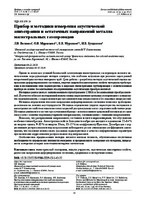Прибор и методики измерения акустической анизотропии и остаточных напряжений металла магистральных газопроводов

Date
2019Publisher
Another Title
Device and Methods for Measuring of Acoustic Anisotropy and the Residual Stress in the Main Gas Pipelines Metal
Bibliographic entry
Прибор и методики измерения акустической анизотропии и остаточных напряжений металла магистральных газопроводов = Device and Methods for Measuring of Acoustic Anisotropy and the Residual Stress in the Main Gas Pipelines Metal / Л. В. Волкова [и др.] // Приборы и методы измерений : научно-технический журнал. – 2019. – Т. 10, № 1. – С. 42-52.
Abstract
Одним из основных условий безопасной эксплуатации магистральных газопроводов является использование неразрушающих методов контроля, что особенно актуально при решении задач ранней оперативной диагностики материала труб. Цель работы – разработка методик акустической оценки напряженно-деформированного состояния, упругих модулей и анизотропии свойств материала трубопровода и исследование этих характеристик в вырезках магистральных трубопроводов с использованием прибора на основе бесконтактных электромагнитно-акустических преобразователей. Методики реализуются с использованием структуроскопа СЭМА и бесконтактных преобразователей. В качестве объекта исследований использованы вырезки магистральных газопроводов с кольцевыми сварными швами, с коррозионным растрескиванием под напряжением и без видимых повреждений.
Методика определения плоского напряженно-деформированного состояния элементов трубопровода основана на явлении акустоупругости. Методика определения упругих характеристик материалов и анизотропии их свойств основана на связи скоростей ультразвуковых волн с упругими свойствами среды. Методики реализуются за счет прозвучивания образца с использованием продольной волны и двух сдвиговых волн с взаимно перпендикулярными поляризациями, совпадающими с главными напряжениями. Показано, что распределение напряженного состояния является неравномерным, что обусловлено особенностями образцов. Анизотропия свойств большинства образцов находится в диапазоне 12–14 % по модулю сдвига, 9–10 % по модулю Юнга, 13–15 % по коэффициенту Пуассона. Для образцов с коррозионным растрескиванием под напряжением наблюдается резкое уменьшение коэффициента анизотропии, что позволяет использовать указанные характеристики в качестве информативных параметров
при выявлении коррозионного растрескивания под напряжением. Особенностью предложенных методик является высокая точность, обусловленная отсутствием необходимости определения плотности материала и прецизионного измерения его толщины, погрешность измерения которых известными методами значительна.
Abstract in another language
One of the main conditions of safe operation of gas pipelines is the use of non-destructive diagnostic methods. Particularly important problem is the earlier operational diagnosis of pipes’ material of main gas pipelines based on the evaluation of the stress-strain state, elastic moduli and properties anisotropy by acoustic methods. The aim of the work is to develop methods for acoustic assessment of the stress-strain state, the elastic moduli and the properties anisotropy of pipeline material and to study these characteristics in different sections of main pipelines using a device based on contactless EMA transducers. Methods are implemented using specialized equipment (the structurescope SEMA) and non-contact electromagnetic acoustic transducers. As an object of research, we used fragments – the cuttings of gas pipelines
with circumferential welds both after fabrication and removed from service with stress corrosion cracking, including ones with corrosion damage and without visible damage. The method of determining the plane stress-strain state of pipeline elements is based on the phenomenon of acoustoelasticity – the dependence of the propagation velocity of ultrasonic waves on mechanical stresses. The method for determining the elastic characteristics of materials and the anisotropy of their properties is based on the relationship between the velocities of ultrasonic waves and the elastic properties of the medium. Both techniques are implemented by sounding the sample in one section using a longitudinal wave and two shear waves with mutually perpendicular polarization planes coinciding with the main stresses, and measuring their propagation times. It is shown that the stress state distribution both in the circumferential direction and along the generatrix is uneven which is caused by the peculiarities of samples (presence of a welded joint, stress corrosion cracking,
long-term operation). The smallest acoustic anisotropy is observed for the Young's modulus. The anisotropy of the properties of most samples is in the range of 12–14 % for shear modulus, 9–10 % for Young’s modulus, 13–15 % for Poisson’s ratio. For samples with stress corrosion cracking a sharp decrease in the anisotropy coefficient is observed which makes it possible to use the indicated characteristics as informative parameters in detecting stress corrosion cracking. A feature of the proposed methods is high accuracy, due to the absence of necessity to determine the material density and precision measurement of its thickness, the measurement error of which is significant by known methods.
View/
Collections
- Т. 10, № 1[11]
